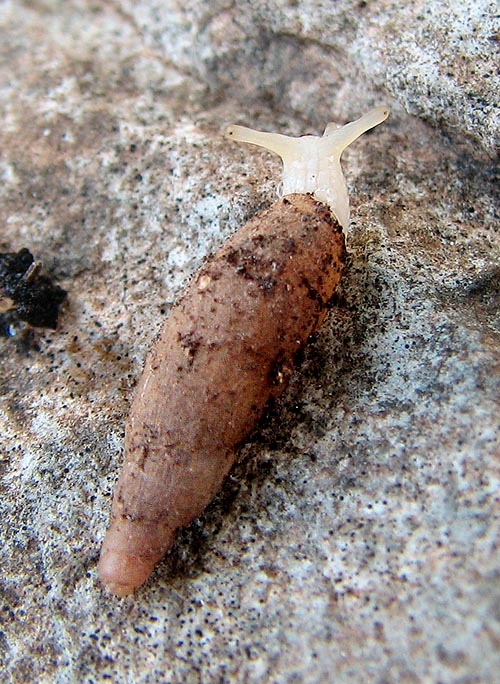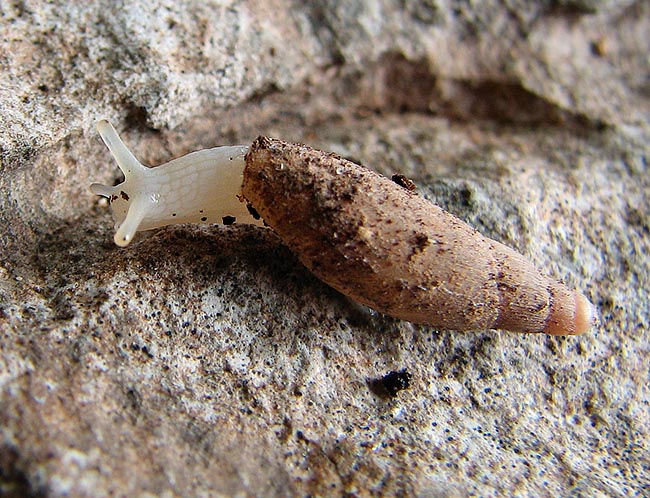Family : Oleacinidae

Text © Gianbattista Nardi

English translation by Mario Beltramini

Sardopoiretia emanueli is a Sardinian endemism © Gianbattista Nardi
Zoogeography
Sardopoiretia emanueli Bodon, Nardi, Braccia & Cianfanelli, 2010, endemic Italian entity, is known up to now only in a fairly small area not far from the central-eastern coast of Sardinia (municipality of Baunei, Ogliasta).
The genus Poiretia, by far the most close genus to it, is on the contrary distributed over the European-Mediterranean area: Poiretia algira (Bruguière, 1792) in Algeria; Poiretia compressa (Mousson, 1859), in Albania and in Greece; Poiretia delesserti (Bourguignat, 1852), in Albania and in Greece too; Poiretia mingrelica (Boettger, 1881) only in the Caucasus; Poiretia cornea (Brumati, 1838) from Italy (Euganean Hills, eastern sector of Friuli-Venezia Giulia, Gargano) up to the western Balkans (Slovenia, Croatia, Bosnia and Herzegovina, Serbia, Montenegro and Albania); Poiretia dilatata (Philippi, 1836) which includes, besides the typical subspecies P. d. dilatata, present in peninsular Italy (Marches, Umbria, southern Italy) and in Sicily, also P. d. marginata (Westerlund, 1886), of Crete and P. d. peloponnesica Subai, 1980 of Peloponnesus.
Ecology-Habitat
The living specimen and most of the shells of Sardopoiretia emanueli have been collected in depth (50-80cm) in the calcareous soil, among the roots of a carob tree (Ceratonia siliqua) or in the deep layer of the stony soil covered by Mediterranean maquis. Other shells were collected in alluvial debris in a spring with schistose lithology. They have never found any one in the surface or in the litter. From this and from the anatomical peculiarities characterizng the living specimen (depigmentation and micro-ophtalmia), it appears that this entity is endogenic, perfectly adapted to the life in the subsurface layers of the soil.
Morpho-physiology
The shell of Sardopoiretia emanueli (height 15,2-21,1 mm; diameter 4,2-5,6 mm) has dextral coiling, is of medium size, slender and fusiform, with high spire and obtuse apex. It is composed by 5-5½ turns of fast growing spire, the last one being very ample, so to form the 2/3-3/4 of the height of the whole shell. The sutures of the shell are marked but little deep, scalloped. The opening is elongated, oblong-pyriform, prosocline, acute above, approximately 2/5 of the total height of the shell. The peristome appears in contact with the last turn, interrupted, neither thickened nor reflected, with slightly winding outer edge; its upper and lower vertices are united by a slight callosity. The columella is slightly concave, truncated obliquely at the base. The umbilicus is absent. The outer surface of the protoconch is smooth; the one of the first spire is crossed by weak radial rugosities, with erratic trending, intersecting. The following turns are ornamented by radial little prominent ribs, slightly sinuous, more marked in the upper part and thicker, thinner and more attenuated in the basal portion. In the last turn, the number of the ribs varies from 7 to 9 per mm in the upper portion and from 18 to 28 per mm in the lower one, due to the appearance of secondary ribs, intercalated to the main ones. The colour of the shell is whitish, pale and a little transparent if the shell is fresh. Some characters of the shell of Sardopoiretia (fusiform look, marked axial sculpture, columella truncated at the base) allow drawing it to the genus Poiretia. However, S. emanueli distinguishes from the species of this genus, for the smaller size, the slimmer shape and for the particular micro-sculpture of the first turn of the teleoconch.

It lives 50-80 cm deep, in calcareous soils, often among Ceratonia siliqua roots © Gianbattista Nardi
Ethology
Sardopoiretia emanueli has been collected in the soil along with other empty shells, some belonging to equally hypogeous species (Hypnophila girottii Esu, 1978 and Hypnophila bisacchii Giusti, 1970), others belonging to surface species (Cochlostoma sardoum Westerlund, 1890): all of them did show clear signs of predation on the first turns of spire or on the median ones, consisting in irregular holes consequence of a strong erosive activity. As that the marks of predation are much similar to those produced by Poiretia on the land molluscs of the genera Pomatias and Cochlostoma, and that such perforations have never been found on shells of the three species collected in other areas of Sardinia, it appears logical to conclude that they are, most likely, a consequence of attacks done by Sardopoiretia emanueli.
Final considerations
The discovery of Sardopoiretia emanueli has done nothing but enriching the list of the species of land molluscs endemic to Sardinia and confirming the island as one of the zones with the most naturalistic value of the whole continent, especially in the central-eastern calcareous area.
→ To appreciate the biodiversity within the MOLLUSCS please click here.
